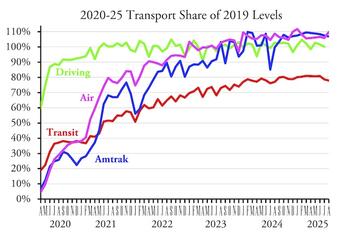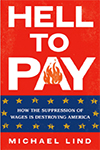
Due to the shutdown of non-essential government services, web sites for the Census Bureau, Bureau of Economic Analysis, Bureau of Transportation Statistics, and other statistical agencies all say that postings of new data will be delayed. But someone at the Federal Transit Administration must think that ridership data is an essential service, for they posted August data on Monday. I didn’t notice it until too late for yesterday’s Antiplanner, but here they are.
Note: August driving data will be posted at Antiplanner whenever it becomes available, or at least when I notice it becomes available.
The numbers show that transit carried 77.8 percent as many riders in August 2025 as in the same month in 2019. That’s the lowest since August 2024. Admittedly, transit data for Las Vegas are missing, but that will add only about 0.1 percent to the total. No other major urban area appears to be missing data.
Missing data were a bigger issue in July, when ridership numbers were missing for at least a dozen major urban areas. Those numbers are in the August report and I have updated the chart above to include them, increasing ridership (as a share of 2019) from 76.6 percent to 78.7 percent. To be complete, I updated the chart going back to the beginning of 2024; numbers before that were unchanged.
The chart shows that transit ridership has pretty much leveled off at around 80 percent of pre-pandemic numbers. Not counting February, 2024, which had a leap day (adjusted for in the chart), monthly ridership first reached 80 percent of 2019 numbers in October, 2024, and hasn’t ascended to 81 percent since then. It has declined for the last two months.
Although transit agencies are still providing 94 percent as much service as they did in 2019 (and more than 100 percent as much as in 2024), many agencies are complaining that they’ve run out of federal COVID relief funds and will have to cut service. In fact, this is a self-inflicted problem: instead of using relief funds to maintain their operations, most agencies used them to give employees large pay increases and especially to increase pay in the executive suites.
Yet worries about a fiscal cliff are leading to much hand-wringing on the part of many people who would never themselves ride transit. “A shortfall in federal transportation funding is threatening bus and metro systems across the country,” says PBS. Say what? There is plenty of federal transportation funding. The problem is a shortfall in riders.
Planetizen blames the problem on the theory that, “for labor-intensive industries, operating costs over time will rise faster than inflation.” But transit’s problem is much more severe: transit’s worker productivity (the number of riders carried per worker) has declined dramatically, mainly because agencies have hired new workers even when not justified by increased ridership. Since agencies get most of their funds from taxpayers, not riders, they haven’t been concerned about constraining labor costs.
Bloomberg is at least willing to ask if we should “let public transit die?” But that’s not really the question. The question should be: should we let transit subsidies die, or at least shrink? Rather than seriously consider such a question, Bloomberg simply asserts that there are unacceptable “economic and social costs of cutting service.”
Most of those economic and social costs are simply imaginary. Supposedly, transit uses space more efficiently than cars. Certainly that’s true in the case of subway systems, especially in New York City. Elsewhere, not so much. A bus with six passengers (the average number carried in 2023) occupies as much space as several cars. Besides, space is not in short supply in most American cities unless it has been made so artificially using such tools as urban-growth boundaries.
Read the rest of this piece at The Antiplanner.
Randal O'Toole, the Antiplanner, is a policy analyst with nearly 50 years of experience reviewing transportation and land-use plans and the author of The Best-Laid Plans: How Government Planning Harms Your Quality of Life, Your Pocketbook, and Your Future.
Photo: chart courtesy The Antiplanner.












